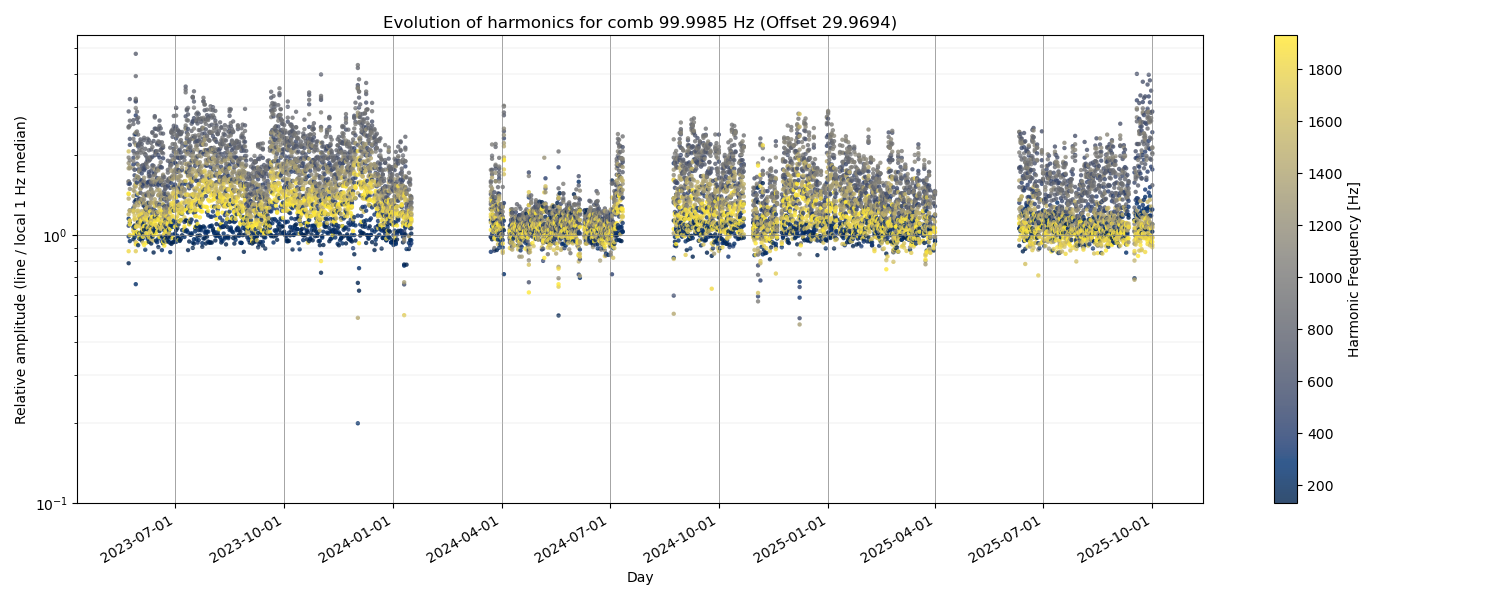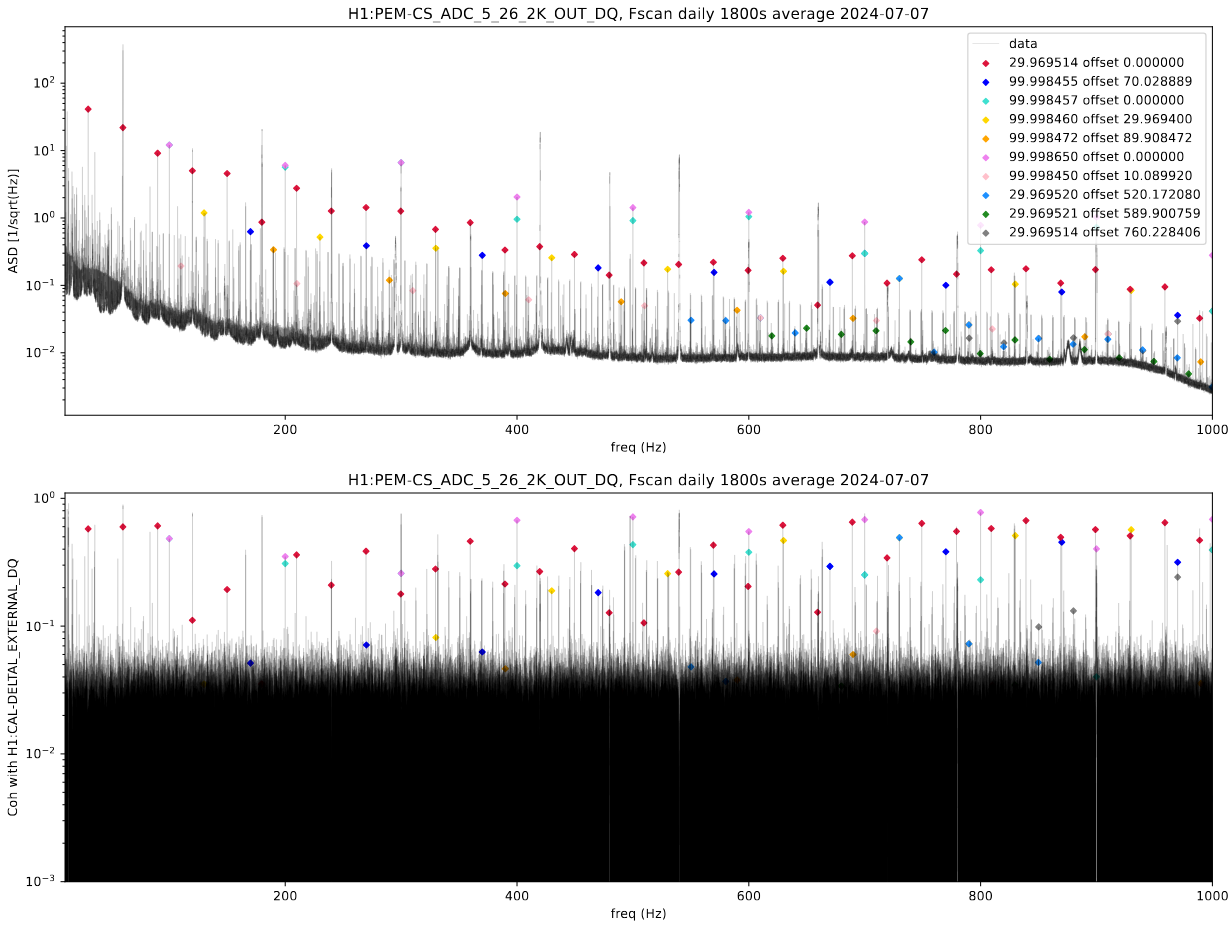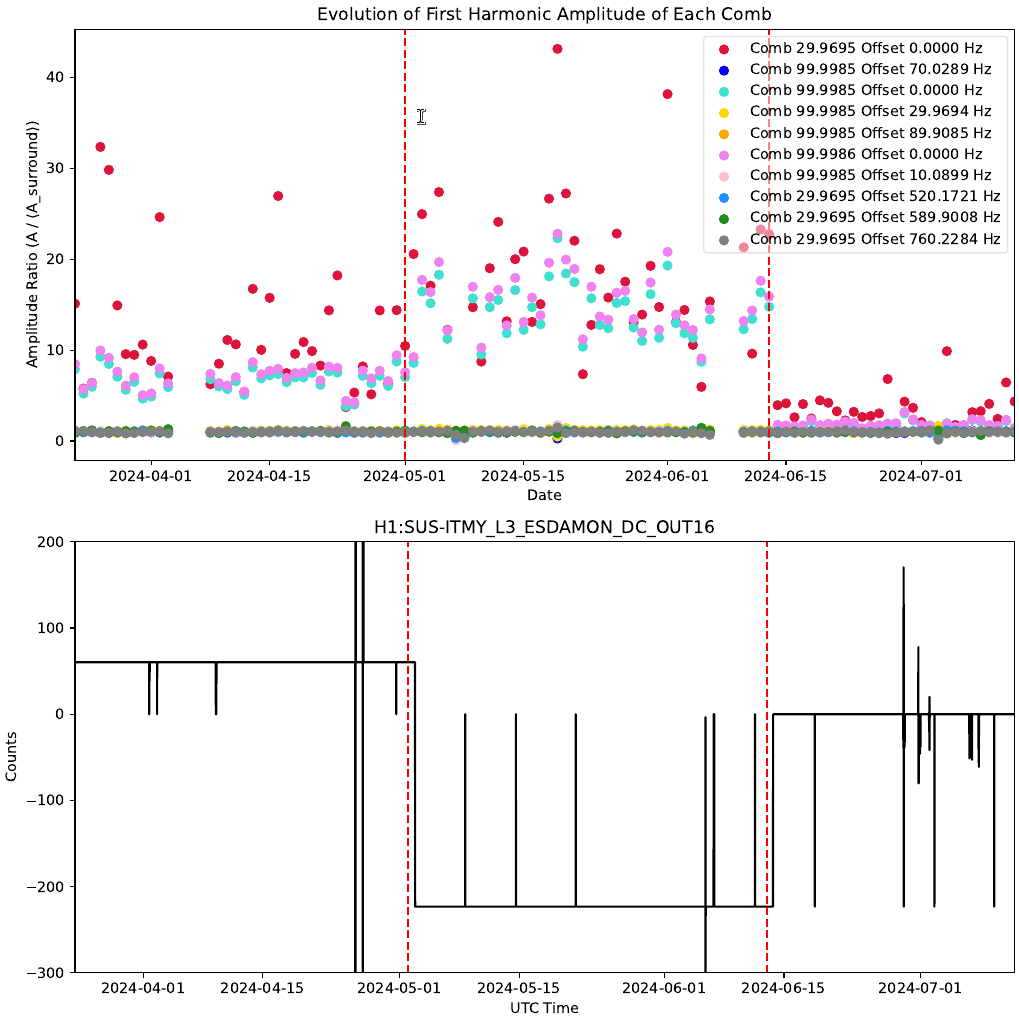Follow up to Oli's measurements on [LHO: 87362].
We fit the eight (yes, eight!) transfer functions needed for a full L-P M1 OSEM estimator for PR3. The measurements for PR3 were remarkably clean, so it was pretty close to just automated. I spent a lot of time cleaning up Ivey's code so it hopefully can be scaled up to other suspensions more easily.
The relevant fits are shown in the attached .pdf They are suspoint {L,P} to M1 {L,P} (4 fits), and M1 drive {L,P} to M1 {L,P} (4 fits). The estimator's control stability only depends on the M1 drive models, which are fit surprisingly well.
I will note that the L-P plant for PR3 is remarkably reciprocal, and I actually expect to see good performance of the estimators when we try them.
The fits were committed to the sus svn together with a script to install them under revision 12734.
The files live in (svnRoot)/sus/trunk/HLTS/Common/FilterDesign/Estimator/ and are named:
make_PR3_estimator_LP.m
fits_H1PR3_LP-2025-10-07.mat
_______________
These are the .zpk for the fits:
SUSPOINT TO M1
Suspoint L to M1 L fit
zpk([0,0,-0.223-4.338i,-0.223+4.338i,-0.04-7.231i,-0.04+7.231i,-0.122-15.233i,-0.122+15.233i],[-0.07-4.099i,-0.07+4.099i,-0.111-4.714i,-0.111+4.714i,-0.11-9.997i,-0.11+9.997i,-0.234-18.094i,-0.234+18.094i],-0.001)
Suspoint L to M1 P fit
zpk([0,0,0.954-6.919i,0.954+6.919i,-0.925-7.247i,-0.925+7.247i,-0.03-17.396i,-0.03+17.396i,-0.026-20.357i,-0.026+20.357i],[-0.083-4.115i,-0.083+4.115i,-0.09-4.669i,-0.09+4.669i,-0.107-9.984i,-0.107+9.984i,-0.288-13.181i,-0.288+13.181i,-0.275-18.054i,-0.275+18.054i,-0.084-22.109i,-0.084+22.109i],0.373)
Suspoint P to M1 L fit
zpk([0,0,-0.204-4.277i,-0.204+4.277i,-0.081-9.662i,-0.081+9.662i,0.016-17.983i,0.016+17.983i],[-0.044-4.018i,-0.044+4.018i,-0.102-4.661i,-0.102+4.661i,-0.028-9.938i,-0.028+9.938i,-0.018-18.044i,-0.018+18.044i],0)
Suspoint P to M1 P fit
zpk([0,0,-0.02-4.046i,-0.02+4.046i,-0.005-4.779i,-0.005+4.779i,0.017-5.716i,0.017+5.716i,0.003-9.719i,0.003+9.719i,-0.175-9.79i,-0.175+9.79i,0.075-13.176i,0.075+13.176i,0.001-22.098i,0.001+22.098i],[-0.01-4.018i,-0.01+4.018i,-0.06-4.157i,-0.06+4.157i,-0.06-4.653i,-0.06+4.653i,-0.007-4.797i,-0.007+4.797i,0-9.765i,0+9.765i,-0.017-9.957i,-0.017+9.957i,-0.036-13.12i,-0.036+13.12i,-0.019-22.115i,-0.019+22.115i],-0.001)
M1 DRIVE TO M1
M1 drive L to M1 L fit
zpk([-0.137-4.329i,-0.137+4.329i,-0.017-5.169i,-0.017+5.169i,-0.037-12.394i,-0.037+12.394i],[-0.098-4.128i,-0.098+4.128i,-0.09-4.66i,-0.09+4.66i,-0.103-9.985i,-0.103+9.985i,-0.245-18.089i,-0.245+18.089i],0.142)
M1 drive L to M1 P fit
zpk([1.391-5.654i,1.391+5.654i,-1.723-6.019i,-1.723+6.019i,-9,12.605,0.233-16.247i,0.233+16.247i,-0.042-19.777i,-0.042+19.777i],[-0.093-4.125i,-0.093+4.125i,-0.088-4.646i,-0.088+4.646i,-0.102-9.984i,-0.102+9.984i,-0.292-13.17i,-0.292+13.17i,-0.264-18.072i,-0.264+18.072i,-0.085-22.117i,-0.085+22.117i],0.119)
M1 drive P to M1 L fit
zpk([1.425-5.579i,1.425+5.579i,-1.619-6.117i,-1.619+6.117i,-9.724,13.511,0.26-16.388i,0.26+16.388i,-0.122-19.664i,-0.122+19.664i],[-0.092-4.129i,-0.092+4.129i,-0.097-4.664i,-0.097+4.664i,-0.081-9.967i,-0.081+9.967i,-0.298-13.165i,-0.298+13.165i,-0.27-18.058i,-0.27+18.058i,-0.08-22.14i,-0.08+22.14i],0.115)
M1 drive P to M1 P fit
zpk([-0.068-4.408i,-0.068+4.408i,-0.012-5.489i,-0.012+5.489i,-0.108-10.011i,-0.108+10.011i,-0.023-21.169i,-0.023+21.169i],[-0.089-4.125i,-0.089+4.125i,-0.079-4.666i,-0.079+4.666i,-0.104-9.96i,-0.104+9.96i,-0.29-13.181i,-0.29+13.181i,-0.084-22.141i,-0.084+22.141i],82.922)






















 We list here the channels that do show most of these Combs. These same channels do show changes in coherence between July 1st and July 7th 2024, but do not show changes in the amplitude of the combs.
- H1_IMC-F_OUT_DQ
- H1_LSC-MCL_IN1_DQ
- H1_LSC-MICH_IN1_DQ
- H1_LSC-SRCL_IN1_DQ
- H1_PEM-CS_MAG_EBAY_LSCRACK_X_DQ
- H1_PEM-CS_MAG_EBAY_LSCRACK_Y_DQ
- H1_PEM-CS_MAG_EBAY_LSCRACK_Z_DQ
- H1_PEM-CS_MAG_LVEA_INPUTOPTICS_X_DQ
- H1_PEM-CS_MAG_LVEA_INPUTOPTICS_Y_DQ
- H1_PEM-CS_MAG_LVEA_INPUTOPTICS_Z_DQ
In most channels, the comb amplitude tends to get quite low after ~1500 Hz. The following sets of channels show differences between X, Y and Z:
- H1_PEM-CS_MAG_EBAY_SUSRACK_X_DQ (Higher amplitudes and towards higher frequencies)
- H1_PEM-CS_MAG_EBAY_SUSRACK_Y_DQ (Lower comb amplitudes)
- H1_PEM-CS_MAG_EBAY_SUSRACK_Y_DQ (Lower comb amplitudes)
Regarding CS_MAG_LVEA_OUTPUTOPTICS, these combs can be seen best in X, weaker in Y and almost non-existent in Z. (In CS_MAG_LVEA_INPUTOPTICS they look roughly the same height)
- H1_PEM-CS_MAG_LVEA_OUTPUTOPTICS_X_DQ (Strongest)
- H1_PEM-CS_MAG_LVEA_OUTPUTOPTICS_Y_DQ (Weaker lines)
- H1_PEM-CS_MAG_LVEA_OUTPUTOPTICS_Z_DQ (Almost no lines)
Same behavior at:
- H1_PEM-CS_MAG_LVEA_VERTEX_X_DQ (Strongest lines)
- H1_PEM-CS_MAG_LVEA_VERTEX_Y_DQ (Weaker lines)
- H1_PEM-CS_MAG_LVEA_VERTEX_Z_DQ (Almost no lines)
We can see that these combs mostly appear in the corner station. The combs do not appear in neither EX nor EY channels. However, comb 99.99865 Hz offset 0.000 appears in many EX, EY channels and does become more coherent after July 7th. However, it is very close to 100 Hz so it may be influenced by other round-number combs (?)
We list here the channels that do show most of these Combs. These same channels do show changes in coherence between July 1st and July 7th 2024, but do not show changes in the amplitude of the combs.
- H1_IMC-F_OUT_DQ
- H1_LSC-MCL_IN1_DQ
- H1_LSC-MICH_IN1_DQ
- H1_LSC-SRCL_IN1_DQ
- H1_PEM-CS_MAG_EBAY_LSCRACK_X_DQ
- H1_PEM-CS_MAG_EBAY_LSCRACK_Y_DQ
- H1_PEM-CS_MAG_EBAY_LSCRACK_Z_DQ
- H1_PEM-CS_MAG_LVEA_INPUTOPTICS_X_DQ
- H1_PEM-CS_MAG_LVEA_INPUTOPTICS_Y_DQ
- H1_PEM-CS_MAG_LVEA_INPUTOPTICS_Z_DQ
In most channels, the comb amplitude tends to get quite low after ~1500 Hz. The following sets of channels show differences between X, Y and Z:
- H1_PEM-CS_MAG_EBAY_SUSRACK_X_DQ (Higher amplitudes and towards higher frequencies)
- H1_PEM-CS_MAG_EBAY_SUSRACK_Y_DQ (Lower comb amplitudes)
- H1_PEM-CS_MAG_EBAY_SUSRACK_Y_DQ (Lower comb amplitudes)
Regarding CS_MAG_LVEA_OUTPUTOPTICS, these combs can be seen best in X, weaker in Y and almost non-existent in Z. (In CS_MAG_LVEA_INPUTOPTICS they look roughly the same height)
- H1_PEM-CS_MAG_LVEA_OUTPUTOPTICS_X_DQ (Strongest)
- H1_PEM-CS_MAG_LVEA_OUTPUTOPTICS_Y_DQ (Weaker lines)
- H1_PEM-CS_MAG_LVEA_OUTPUTOPTICS_Z_DQ (Almost no lines)
Same behavior at:
- H1_PEM-CS_MAG_LVEA_VERTEX_X_DQ (Strongest lines)
- H1_PEM-CS_MAG_LVEA_VERTEX_Y_DQ (Weaker lines)
- H1_PEM-CS_MAG_LVEA_VERTEX_Z_DQ (Almost no lines)
We can see that these combs mostly appear in the corner station. The combs do not appear in neither EX nor EY channels. However, comb 99.99865 Hz offset 0.000 appears in many EX, EY channels and does become more coherent after July 7th. However, it is very close to 100 Hz so it may be influenced by other round-number combs (?)




















